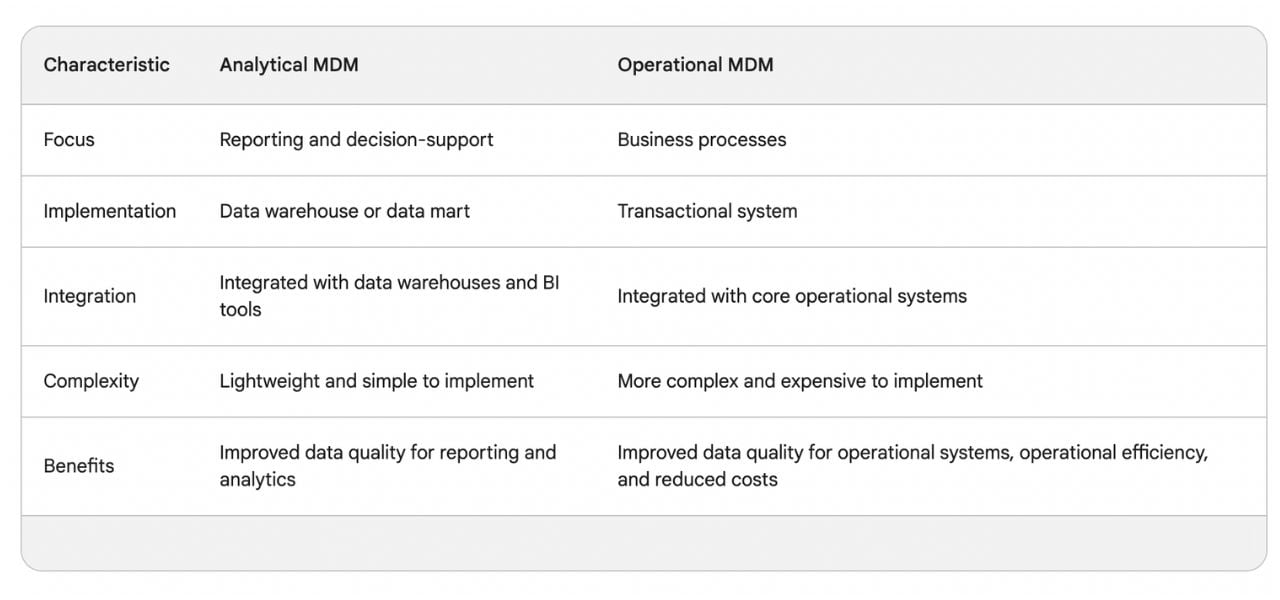In an age where data reigns supreme, organisations find themselves with a wealth of information at their disposal. Experts estimate we produce around 2.5 quintillion bytes of data each day – used for everything from improving customer satisfaction levels to making crucial business decisions.
But the more data we have, the harder it is to manage. And when not organised effectively, your organisation’s most valuable data can become unreliable, inefficient and effectively useless.
Luckily, master data management (MDM) is here to help. This article covers everything you need to know about master data management, exploring its meaning and architecture while giving real-world examples of MDM solutions in action.

What is master data management (MDM)? Definition
Master Data Management is a strategy that helps your organisation manage, store, and leverage its most important data effectively.
It specifically focuses on managing master data – which consists of crucial information you use to run your business, such as customer data, product data, or supplier data.
Master data management helps organisations create a single, authoritative source of truth for this master data, allowing them to create policies for handling their master dataset and all critical information stored within it. This can help improve crucial decision-making, streamline operations, and reduce costs.
Understanding MDM Architecture: Analytical MDM vs Operational MDM
MDM architecture can be broadly categorised into two main types: Analytical MDM and Operational MDM. These two approaches have different purposes and use cases:
- Analytical MDM is focused on providing clean, coordinated data for reporting and decision-support systems like machine learning-based analytics. It is typically implemented as a data warehouse or data mart, and it is often used to support business intelligence (BI) and predictive analytics. Analytical MDM is typically lightweight and simple to implement, but it does not provide better data quality in originating systems that can promote operational and administrative efficiencies.
- Operational MDM is focused on providing clean, trusted data to support business processes in real-time. It is typically implemented as a transactional system that is integrated with the organization's core operational systems, such as CRM and ERP. Operational MDM is more complex and expensive to implement than Analytical MDM, but it can provide significant benefits in terms of improved data quality, operational efficiency, and reduced costs.
The following table summarises the key differences between Analytical MDM and Operational MDM:

Analytical MDM vs Operational MDM: Choosing an Approach
You should choose the approach to MDM that best meets your specific needs and requirements. For example, if your organisation is focused on improving its reporting and analytics, Analytical MDM may be a better choice for you.
But if you’re more focused on improving the operational efficiency and data quality your its core operational systems, Operational MDM is probably more what you’re looking for.
Many organisations choose to implement a hybrid approach to MDM, which combines elements of both Analytical MDM and Operational MDM.
A hybrid approach to MDM is typically implemented using a master data hub. The hub is a central repository that stores a single, authoritative version of the organization's master data. The hub is integrated with the organisation's source systems, such as CRM and ERP, as well as its data warehouses and Business intelligence tools.
Examples of MDM
Before we explore some examples of master data management in action, we first we go into more detail about the types of data included within the master data dataset.
Some of the most common examples of master data include:
- Customer information: Names, phone numbers, addresses, and other critical customer insights are excellent examples of master data. Maintaining accurate customer data ensures you can enhance and maintain positive relationships with clients.
- Transactional data: This is the information recorded about the time, place, and details of various transactions. It’s often important in making business decisions, like deciding which sales avenues to leverage, or which products to promote.
- Product data: Product information can include everything from the details surrounding a product and its capabilities to the materials used to make that product, inventory information, and supply chain elements.
Examples of MDM in action
MDM can be implemented in a variety of ways, depending on the size and needs of the organisation. Some organizations may choose to implement a full-blown MDM solution to manage this master data, while others may choose to implement a more lightweight approach.
Here are some examples of master data management in action:
- A retail company could use it to create a single view of its customer data. This would allow the company to better understand its customers and target its marketing campaigns more effectively.
- A financial services company could use MDM to create a single view of its product data. This allows the company to more easily manage its product portfolio and provide better service to its customers.
- A manufacturing company could use MDM to create a single view of its supplier data. This allows the company to better manage its supply chain and reduce costs.
- A healthcare organization could use MDM to create a single view of its patient data. This allows the organisation to provide better care to its patients and improve its clinical outcomes.
Why Is MDM Important?

Master data management (MDM) is important because it helps organisations improve the quality, consistency, and accuracy of their master data. This core data is essential to the organization's operations, and, if managed correctly, can mean the difference between thriving and failing in today’s business environment.
Read our top 10 best Master Data Mangement tools for your business.
Master data management solutions also offer a number of key benefits for organisations of all sizes. Some key benefits of MDM include:
- Improved data quality: MDM can help organizations improve the quality of their master data by cleansing, standardizing, and integrating the data from multiple sources. This can lead to improved decision-making, operational efficiency, and customer service.
- Reduced costs: MDM can help organizations reduce costs by eliminating duplicate data and improving the accuracy of their data. This can lead to reduced costs for data storage, data processing, and data analysis.
- Improved decision-making: MDM can help organizations make better decisions by providing them with a single, trusted source of truth for their master data. This can help organizations to make more informed decisions about their customers, products, and suppliers.
- Enhanced operational efficiency: MDM can help organizations improve their operational efficiency by automating manual data management tasks and providing a single point of access to master data. This can free up employees to focus on more strategic tasks and improve the overall efficiency of the organization.
- Improved customer and partner relationships: MDM can help organizations improve their customer and partner relationships by providing them with a consistent and accurate view of their master data. This can lead to improved customer service, better customer satisfaction, and stronger relationships with partners.
- Accelerated time to market: Insights into products and supply chains can help businesses to accelerate their time to market. According to one study, 58% of organisations using MDM solutions were able to reduce their time to market from months to only weeks. Faster time to market means faster revenue growth.
- Increased compliance with regulatory requirements: MDM can help organisations increase their compliance with regulatory requirements by providing them with a single, trusted source of truth for their master data. This can help organizations to avoid fines and penalties associated with non-compliance and make their data more secure.
Challenges of Master Data Management (MDM)
Master data management (MDM) is a complex and challenging process, and there are a number of key challenges that organizations face when implementing MDM. Some of the most common challenges include:
- Data complexity and diversity. Organizations typically have large volumes of data stored in a variety of different systems and formats. This can make it difficult to identify, source, cleanse, and integrate the data into a single master repository.
- Data quality. The quality of master data can vary significantly across different systems and sources. This can make it difficult to ensure that the data in the master repository is accurate, consistent, and complete.
- Data governance. MDM requires a strong data governance framework to ensure that the data is managed and used effectively. This includes developing and implementing policies and procedures for data ownership, data access, and data change management.
- Technical challenges. MDM can require a significant investment in technology, including MDM software, data integration tools, and data quality management tools.
- Cultural change. MDM requires a cultural change within the organization, as it requires people to change the way they work with data. This can be a challenge, especially in large and complex organisations.
As well as the challenges listed above, organizations may also face specific challenges related to their industry or business model. For example, organisations in the financial services industry may face challenges related to regulatory compliance, while organisations in the healthcare industry may face challenges related to patient privacy.
Best practices for implementing MDM
MDM can be a complex and challenging initiative, but it can provide significant benefits to organizations that implement it effectively. Here are just some of the best practices you can follow when implementing MDM:
- Start small. It's better to start with a small MDM project than to try to boil the ocean. This will help the organization to learn from its mistakes and make necessary adjustments as it moves forward.
- Focus on the most important data domains. The organization should focus on the master data domains that are most critical to its business. This will help the organization to realize the most benefits from its MDM initiative.
- Get buy-in from stakeholders. It's important to get buy-in from the stakeholders who will be using the MDM solution. This will help ensure that the solution is adopted and used effectively.
- Invest in training. The organization should invest in training for its users on how to use the MDM solution. This will help ensure that users are able to use the solution to its full potential.
- Monitor and evaluate the MDM solution. The organization should monitor and evaluate the MDM solution on a regular basis to ensure that it is meeting its needs. This will help the organization to identify any areas where the solution can be improved.
- Don't wait until your data is perfect. It's better to start with MDM now, even if your data is not perfect. MDM can help you to improve the quality of your data over time.
- Don't try to do everything at once. MDM is a complex initiative, so it's important to break it down into smaller, more manageable projects.
- Don't be afraid to ask for help. There are a number of MDM experts and consultants who can help you implement and manage your MDM solution.
By following these best practices and tips above, your organisation can increase its chances of success with MDM.
Key Steps for MDM: How to Get Started

Getting started with MDM involves several key steps that pave the way for a successful implementation. The process can be implemented using a variety of tools and technologies, but the basic steps are the same.
Here are the key steps for implementing Master data management:
- Identify and define the master data domains. The first step in the MDM process is to identify the core data entities that are critical to the organization's business. This may include entities such as customers, products, suppliers, employees, and locations. Once the master data domains have been identified, the next step is to define the attributes of each entity. For example, the customer entity may have attributes such as name, address, phone number, and email address.
- Source the master data. The next step in the MDM process is to identify the different systems and sources where the master data is currently stored. This may include enterprise resource planning (ERP) systems, customer relationship management (CRM) systems, and e-commerce platforms. Once the source systems have been identified, the next step is to extract the master data from each system.
- Cleanse and standardize the data. Once the master data has been extracted from the source systems, it needs to be cleansed and standardized. This involves removing duplicate data, correcting errors, and formatting the data in a consistent way. For example, all customer addresses should be formatted in the same way, regardless of which source system they came from.
- Match and merge duplicate data. One of the most important steps in the MDM process is to match and merge duplicate data records from multiple systems into single entries in the master repository. This can be a complex and challenging task, but it is essential for ensuring the accuracy and consistency of the master data.
- Load the master data into a single repository. The next step in the MDM process is to load the master data into a single repository. This repository can be an on-premises system, a cloud-based system, or a hybrid solution. Once the master data has been loaded into the repository, it can be accessed by all of the systems that need it.
- Govern and manage the master data. The final step in the MDM process is to govern and manage the master data. This involves establishing policies and procedures for maintaining the accuracy and consistency of the master data. These policies and procedures should address issues such as data ownership, data access, and data change management.
How to maintain master lists
Maintaining master lists is at the heart of any Master Data Management process These lists typically include data related to customers, products, employees, suppliers, and other critical business entities.
Here are a few key things to keep in mind when maintaining master lists:
- Keep them up to date. This means regularly reviewing and updating the lists to reflect changes in the data.
- Make them easy to use. The lists should be well-organized and easy to search and navigate.
- Restrict access to authorized users. This helps to protect the security and integrity of the data.
- Use a central repository. This helps to ensure that all users are accessing the same data and that updates are made in one place.
- Have a process in place for managing changes. This helps to ensure that changes are made consistently and accurately.
Key roles and individuals involved in the MDM Process
As well as following a number of key steps and best practices, implementing MDM successfully requires the collaboration of various roles and individuals within an organization.
Here are the key roles and responsibilities involved in the MDM process:
- Executive Sponsor: This is the senior leader who is responsible for the overall success of the MDM initiative. The MDM Executive Sponsor provides support and resources to the MDM team and ensures that the MDM initiative is aligned with the organization's overall goals and objectives.
- Program Manager: This is the individual who is responsible for the day-to-day planning and execution of the MDM initiative. The MDM Program Manager works with the MDM team to develop and implement the MDM strategy, manage the MDM budget, and track the progress of the MDM initiative.
- Business Analyst: This is the individual who is responsible for understanding the business requirements for the MDM initiative and translating those requirements into technical specifications. The MDM Business Analyst works with the MDM team to develop the MDM data model, identify the source systems, and define the business rules for the MDM solution.
- Data Steward: This is the individual who is responsible for the quality of the master data. The MDM Data Steward works with the MDM team to define the data quality standards, develop data quality procedures, and monitor the quality of the master data.
- Technical Architect: This is the individual who is responsible for the design and implementation of the MDM solution. The MDM Technical Architect works with the MDM team to select the MDM software, develop the MDM architecture, and integrate the MDM solution with the organization's existing systems.
- MDM Developer: This is the individual who is responsible for developing and maintaining the MDM software. The MDM Developer works with the MDM team to implement the MDM data model, develop the MDM business rules, and build the MDM user interface.
- MDM Quality Assurance Engineer: This is the individual who is responsible for testing the MDM solution to ensure that it meets the organization's requirements. The MDM Quality Assurance Engineer works with the MDM team to develop test cases, execute test cases, and report on the results of the testing.
Final thoughts
Master Data Management (MDM) is a critical discipline for organizations looking to harness the full potential of their data. Whether you’re adopting an analytical or operational MDM approach, you’ll need must address challenges related to data quality, governance, integration, and scalability.
By implementing and maintaining an effective MDM solution, you can ensure that your data is accurate, consistent, and complete. This can help you improve your decision-making, streamline your operations, and ultimately make better business decisions.







Comments ( 0 )